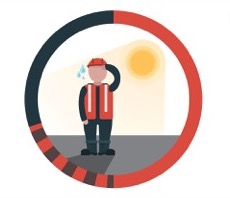
Working Safely as Temperatures Rise
 Rising summer temperatures make the probability of hazardous heat exposure a real threat for many workers. In fact, there are more than 1,300 deaths in the United States each year due to extreme heat exposure, per the Environmental Protection Agency (EPA).
Rising summer temperatures make the probability of hazardous heat exposure a real threat for many workers. In fact, there are more than 1,300 deaths in the United States each year due to extreme heat exposure, per the Environmental Protection Agency (EPA).
Thousands of workers face potential dangers from overexposure to heat—even those who primarily work indoors, such as employees in the food service industry, are at risk. As such, a safe work environment is important to protect all employees from occupational heat exposure, regardless of their particular job duties.
As temperatures begin to rise, employers should be aware of heat-related illnesses that can stem from heat exposure, as well as how to prevent and respond to these illnesses within their workforces. That being said, employers should follow these precautions:
- Install water coolers and provide water bottles in break rooms or other easily accessible areas. Encourage employees to take frequent hydration breaks.
- Schedule physically demanding outdoor work in the early mornings or evenings, when it’s typically cooler outside. Schedule shorter shifts if work conditions seem too hot.
- Have employees apply cold compressions to their heads, necks and faces to reduce their body temperatures if they feel overheated. Install portable fans or provide air-conditioned areas in the workplace where employees can properly cool off.
- Call 911 immediately if any employees display signs of heat stroke. These signs include a high body temperature, seizures, confusion and loss of consciousness. Heat stroke is a very serious health condition, where heat shocks the body’s cooling system and causes it to shut down. Professional medical attention is necessary to adequately treat this condition.
With summer just around the corner, employers should ensure that these measures are in place to properly protect their employees in the midst of high temperatures. For more summer safety information, check out the OSHA infographic below.
OSHA Heat Illness Safety Poster

Tags: Heat Illness, Safety Tips
